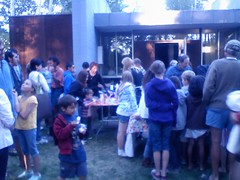| Aspen Center for Physics Summer Solstice Party - Crowding Around For Liquid Nitrogen Ice Cream (Photo credit: richpalpine) |
The crowd was eager, the ice cream was cold, and the stories were, well… spellbinding at the Summer Solstice 2012 party hosted by the Aspen Center for Physics in cooperation with the Aspen Science Center and Spellbinders Storytellers!
Last
Wednesday, the Aspen Center for Physics was the scene for some
entertaining amateur astronomy and summer fun as the Center celebrated
50 years of physics in Aspen by co-hosting an evening of stellar
storytelling, interesting related cosmic facts from Center physicists,
and of course ice cream. Telescopes were also set up on the site.
We
joined the eager crowd, comprised mostly of families with children, in
order to learn a little bit more about the lore of the cosmos. I felt like a kid myself – giddy with anticipation of the activities to come.
While
we waited for darkness to fall, our hosts brought out the some treats –
cookies and ice cream. The liquid nitrogen-cooled creation was smooth and
tasty, very cold, and very popular with this particular crowd. The kids
seemed to like it too!
As darkness began to fall, we settled in at one of the Spellbinders story stations to listen to some cosmic yarns. The storytellers wove tales about the Pleiades, the Big Dipper, and the origin of the Milky Way as seen in our night skies. Visiting astrophysicists then answered questions and doled out interesting facts about the cosmos.
| Aspen Astronomy Waiting For Darkness And The Spellbinder Stories (Photo credit: richpalpine) |
Here are some of the Spellbinders’ stories that we heard at the event:
A Mythological Origin of the Pleiades (Seven Sisters)
Perhaps the most well-known version of the story of the origin of the Pleiades
centers on an ancient Greek myth where, “…seven sisters committed
suicide because they were so saddened by either the fate of their
father, Atlas, or the loss of their siblings, the Hyades. In turn Zeus, the ruler of the Greek gods, immortalized the sisters by placing them in the sky.” -- http://en.wikipedia.org/wiki/Pleiades_(Greek_mythology)
We,
however, were treated to different rendition of the tale based on an
Onondaga Nation (a Native American/First Nations people and one of the
five founding nations of the Iroquois League) where the Pleiades represent “The Children Who Danced Into the Sky”. Apparently,
several children of the Onondaga danced so much, against the warnings
of their elders, that they rose off of the ground, higher and higher,
until they found themselves in the sky and became the seven stars of the
Pleiades star cluster.
The Abenaki Explanation Of The Big Dipper
While
many of us view the Big Dipper as a representation of umm… a big dipper
or ladle, other cultures, including the Abenaki, viewed the bowl stars
of this asterism as “…the Great Bear, who is chased every night by three
hunters; he is killed every fall and his blood drips to earth turning
the leaves brown while the constellation turns upside down; it is
righted, and he is reborn, every spring” – http://en.wikipedia.org/wiki/Abenaki_mythology
How The Milky Way Came To Be
Although many versions of its origin exist, our Spellbinders story of the Milky Way
followed the thread that, according to some ancient cultures, what we
see as the broad, dim band of light in the night skies is a result of a
greedy man who needed straw, stole a load from his neighbor, and flew
his cart into the sky to hide. He flew so quickly that straw flew from his cart across the middle of the sky, marking his getaway path.
After The Spellbinders Stories
There
was a fourth Spellbinders story, but as it got dark enough to see the
stars, and having learned our lesson at the ice cream battle stations,
we decided to beat the crowd to see the planet, Saturn, through the
telescopes that had been set up nearby. We saw the magnificent ringed
planet, and although its bright image was a little bit smaller than I
had hoped for, I could definitely see the rings – the first time for me!
This
was a fabulous, fun and entertaining public event put on by the Aspen
Center for Physics, and I am looking forward to attending another one, a
July 5th talk on “Big Science Questions” by former NASA mission specialist and current NASA Associate Administrator for Science, John Grunsfeld.







No comments:
Post a Comment